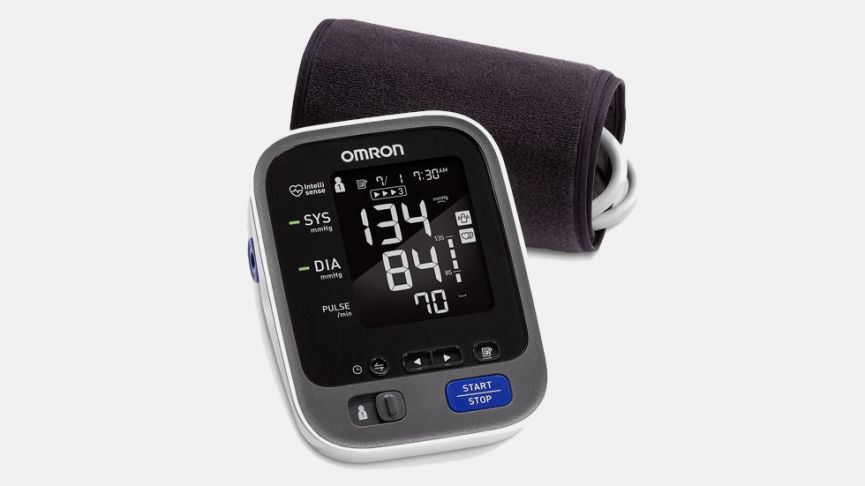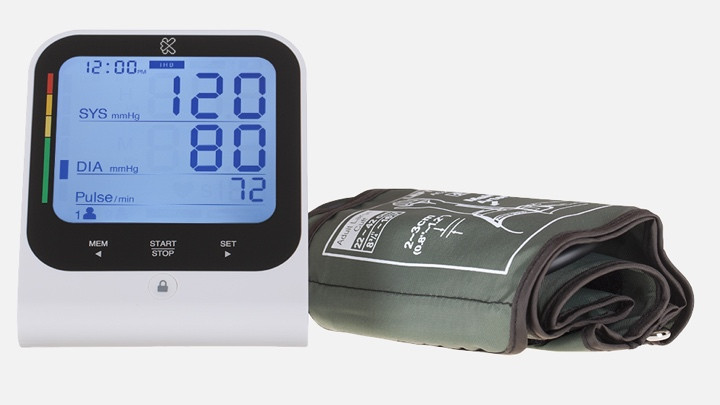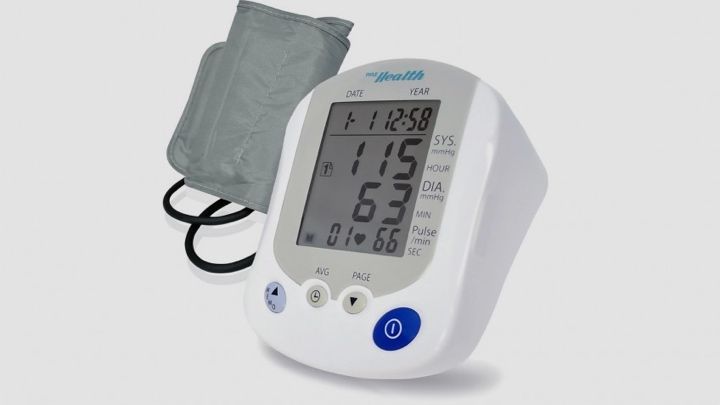
It's estimated that a third of American adults have high blood pressure, which puts them at a higher risk of heart attack or stroke. Too often, diagnosing and monitoring this is left too late.
If having your blood pressure taken at the doctors fills you with dread, investing in a home monitor can take away a lot of the stress. It can also be a lot more convenient. Buying a good blood pressure monitor is a great way of keeping tabs on your body with health tech, and helps to avoid a nasty surprise at the doctors.
Essential reading: Blood pressure is wearable tech's next big challenge
With smarter variants, blood pressure is recorded in a handy app, so you can easily see any
trends or patterns, which can help you to make lifestyle changes more quickly.
What's more, you can show your doctor your results, giving a much more rounded
view of your health.
Until the likes of Apple, Fitbit, Microsoft and Samsung find a way to accurately pack the tech to track blood pressure into a smartwatch or another wearable form, these are the smart monitors we think you should consider.
We also dig into the basics of blood pressure monitoring if you're ready to take readings at home for the first time.
The best overall smart blood pressure monitor
Omron 10 Series
The Omron 10 Series is our pick of the best smart blood pressure monitors for its big easy-to-read screen and accurate results, taken as an average from three consecutive readings. It also supports two users, handy if you have a household with two people needing measurements. It can store 100 readings per person, too.
The best wrist smart blood pressure monitor
Omron HeartGuide
If you're after a wrist blood pressure monitor, the Omron HeartGuide is the best option available. It's the most convenient monitor as it hides the blood pressure cuff in its band. As you constantly wear it, it's able to take readings throughout the day to gather insight into trends.
As a wearable blood pressure monitor watch, it's also able to track steps and monitor your sleep, so the app is able to correlate your blood pressure with your everyday activity. The HeartGuide can also mirror your phone's notifications, adding in some smartwatch functionality.
Explained: Blood pressure monitoring
In this section, we'll be clearing up a few of the common queries you may have about blood pressure and the monitors available on the market. We've already noted how many tech companies are exploring smartwatch-style designs, but the most common kind right now involves a cuff worn over the upper arm to take readings. These work by measuring the strength of the push from your moving blood against the sides of blood vessels, giving you a figure that can help determine if your blood pressure is too high, too low or just right.
What do the numbers mean?
You thought this was all simple, didn't you? Instead you've been taken back to school with this weird fraction figure, when all you wanted was to be responsible and understand your blood pressure. Well, it actually is very straightforward – don't be intimidated. Blood pressure is measured in millimetres of mercury (mmHg) and given as two figures.
The first, and the one on top, is your systolic pressure; the pressure when your heart pushes blood out. The other, and the one below the division bar, is your diastolic pressure; the pressure when your heart rests between beats. So, if your blood pressure monitor shows a reading of 120/70mmHg, it means you have a systolic pressure of 120mmHg and a diastolic pressure of 70mmHg.
What is considered normal, high and low blood pressure?
You may know what the numbers denote, but you'll want to know what they actually mean, and what is considered high, low and 'normal' blood pressure.
Generally speaking, normal is considered to be between 90/60mmHg and 120/80 mmHg, while high is anything around or above 140/90mmHg and low is below 90/60mmHg.
Read this: Everything you need to know about Apple Health
At least in the UK, the NHS indicates that most people sit within the 120/80mmHg and 140/90mmHg range, and while this isn't technically considered high, it is what's known as 'pre-high blood pressure'. Since a higher blood pressure brings with it a greater risk of health problems, such as a heart attack or a stroke, you're still advised to take steps to lower it in this range.
How do I test blood pressure from home?
You can go to your doctor and get your blood pressure reading but, as we've mentioned, that's not the most practical method if you're looking to routinely keep an eye on it.
And there's no point investing in one of the blood pressure monitors detailed below if you don't know what you're doing. Naturally, the process is almost always detailed in instruction manuals, but we know most people don't like trawling through reams of reading.
So, here are a couple of key pointers. A cuff design offers the best accuracy, as opposed to wrist or finger monitors, so you're going to want to probably prioritise that. And when you do wrap this around your upper arm, you need to make sure one you're buying is the right size.
In order to test this, measure the mid-point between your shoulder and forearm – this is where the cuff will sit – and make sure it aligns with the monitor you're looking to purchase. If you don't, you risk winding up with inaccurate readings.
You'll notice that only one blood pressure monitor in the list below takes measurements from your wrist. It's a difficult thing to do accurately, which is why we've yet to see a Fitbit blood pressure monitor. The Omron HeartGuide is currently the only one we recommend as it's gotten FDA approval.
Best blood pressure monitors
Omron 10 Series
Buy now: Amazon | $50

Omron has established quite a name for itself in home blood pressure monitoring, and earns one of two shout-outs on this list for its 10 Series upper arm smart blood pressure monitor. This one has a larger screen than the Evolv, and accuracy is the name of the game here: it takes three consecutive readings (the recommended amount of readings) and works out the average. And, of course, it will let you sync your data with your phone, which includes connectivity to Apple Health.
Another feature we like is the support for two different users, with the capacity to hold 100 readings for each person. This might lack some of the flash of others on the list, but in return you get guaranteed precision.
Omron HeartGuide
Buy now: omronhealthcare.com | $499

The Omron HeartGuide is unique on this list as it's a wrist-based blood pressure monitor watch that's managed to get FDA clearance. It's the best blood pressure watch currently available.
It cleverly hides a blood pressure cuff in the smartwatch, and it won't just keep track of your blood pressure all day whenever you want. You can also track your fitness and get smartphone notifications.
You're only going to need to charge it once or twice a week, as every charge will get you 30 to 50 blood pressure checks (aka inflations of that cuff). Omron is also going to try to get more information on its users – like fitness tracking – to give feedback on insights and trends and help you avoid heart attacks and strokes.
QardioArm
Buy now: Amazon |

This rather elegant, battery-powered model works just like an NHS monitor, only it doesn't look half as ugly. In fact, it's rather Apple-like in design, and that extends to the classy packaging. Using Bluetooth, simply connect the QardioArm monitor to your iOS/Android smartphone, tablet or smartwatch, register your personal details (height, weight, age), wrap the unit around your upper arm and hit the big green start button on your mobile device.
Results – including pulse rate – are automatically synced with the app, which keeps a record of all readings in calendar form. To send the results to your GP, simply hit the standard Apple-designed share icon. Like all the best devices, the QardioArm is easy to use so there's no need for any instruction manual malarkey. It's also eminently portable and available in a range of attractive colours.
Omron Evolv
Buy now: Amazon |

The Omron Evolv is a small, pocket-sized blood pressure monitor that offers connectivity via NFC (near-field communication). Unlike the QardioArm, the Evolv doesn't entertain the user with a pretty bells-and-whistles smartphone interface. Instead, it uses a simple black-and-white display unit, which, in turn, is attached to an inflatable strap that slips onto the upper arm.
You can wirelessly connect to your online dashboard for a digital record of your blood pressure readings, since the device connects to both iOS and Android devices. It's even compatible with Alexa.
Kinetik Bluetooth blood pressure monitor
Buy now: Amazon |

Kinetik's cuff and monitor setup is the most affordable option on our list if you're after a home blood pressure monitor that can send data to your smartphone.
The cuff should fit sizes of 22-42cm and comes equipped with a large, easy to read backlit display that can store 60 user readings. The Bluetooth support means you can connect it to the Kinetik Health Sense companion app, letting you explore your vitals' details in greater depth and get a better understanding of your progress.
Crucially, Kinetik's monitor has been built to the European Society of Hypertension (ESH) and the British Hypertension Society (BHS) guidelines to ensure it's fit for use. Word of warning: This doesn't appear to be available on Amazon US at the moment.
Blipcare Blip Wi-Fi Blood Pressure Monitor
Buy now: Amazon | $159

The Blip Wi-Fi blood pressure monitor doesn't rely on Bluetooth, meaning you don't need a mobile device nearby or even an app to start up the readings. They're simply uploaded automatically using your home Wi-Fi network.
It's easy to use, plus it supports two users and allows for the monitor to be shared. Reminders can also be set up through your online account, with the device beeping at you during the times you've set up.
However, you'll only be reminded if you've missed a reading. Like most of the other blood pressure monitors, you can get reports on the readings to share with family or physician.
Pyle PHBPB20
Buy now: Amazon |

Although this monitor won't win any awards for its aesthetics, it does pack some great features into a simple and effective package. The Pyle Health smartphone app has a clean, colourful design, allowing up to four different users to track their blood pressure.
It can keep tabs on your past results and produce graphs for easy data absorption. These results can then be emailed to your doctor, too, so they can get the detailed information they need to make a relevant reading of your heart health. The Pyle Health app can also work with the Pyle Scales and thermometer, for more comprehensive health coverage.
iHealth Feel
Buy now: Amazon |

Like the QardioArm, this iHealth model is comprised of a large but easily portable measuring unit that inflates a strap around the arm. All results are sent directly to the accompanying free app on your smartphone (both Android and iOS).
The app itself is very well structured with easy-to-follow instructions and we especially like the way it keeps the user informed with an animated graph during the test process. The main unit itself is very similar in design to the QardioArm. The iHealth system works well, too, and the company also produces several other versions if you're looking for a cheaper alternative.
On the horizon…
Asus VivoWatch BP

Omron isn't the only company exploring blood pressure monitoring through the wrist, with Asus soon set to make a return to smartwatches in an unexpected way through the VivoWatch BP.
Using a combination of both ECG and light-based PPG heart monitoring traditionally found in wearables, the device will offer users measurements in real time, while also stretching out as a wider health tracker – heart rate, sleep quality, a de-stress index and activity data are all tracked around the clock.
However, it's also awaiting FDA approval. And though the company has already released the device in Asia, we have no fixed timeline for its release in other territories. If and when it does, it's likely to cost around and feature a 28-day battery life.
How we test
